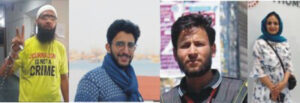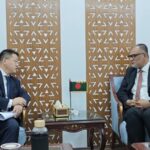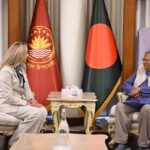 Qazi Mizan: Narendra Modi regime along with establishment has now ordered local Kashmiri newspapers in Indian illegally occupied Jammu and Kashmir (IIOJK) not to publish All Parties Hurriyat Conference (APHC) leaderships’ statements and news including ground situation of the occupied territory.The Modi regime along with Indian army establishment and RSS man Special DG CID /SIUs R R Swain restricted the local Kashmiri newspapers not to publish APHC leaderships’ statements and news including ground situation of Kashmir, which was earlier ordered in August 2019 when Indian government violated international laws and abrogated Article 370 and 35 A of the territory.
Qazi Mizan: Narendra Modi regime along with establishment has now ordered local Kashmiri newspapers in Indian illegally occupied Jammu and Kashmir (IIOJK) not to publish All Parties Hurriyat Conference (APHC) leaderships’ statements and news including ground situation of the occupied territory.The Modi regime along with Indian army establishment and RSS man Special DG CID /SIUs R R Swain restricted the local Kashmiri newspapers not to publish APHC leaderships’ statements and news including ground situation of Kashmir, which was earlier ordered in August 2019 when Indian government violated international laws and abrogated Article 370 and 35 A of the territory.
Over three years since of abrogation of Article 370 and 35 A in occupied Kashmir, APHC, civil society, journalists, lawyers, human rights defenders, common people and other political leaders have faced relentless detentions, interrogations, arbitrary travel bans, revolving door detentions and repressive media policies while they have been denied access to appeals or justice in courts and human rights bodies.
Article 370 and Article 35-A of the Indian constitution, although reduced to an “empty husk” through a series of legislations since 1953, allowed the region to have its own constitution, flag, laws and enshrined the rights of indigenous Kashmiris towards land, education and jobs.
The false promise of normalcy and development in Kashmir
Over three years after the abrogation of the Article 370 and 35 A of Kashmir, the socio-economic situation has deteriorated.
The political and other activities were totally banned and restricted in Kashmir Valley and Muslim dominated areas in Jammu region while the BJP, RSS, Banjrang Dal and other Sangh pariwars are being fully allowed in the Jammu region. To enforce its anti-Kashmir agendas under a military and police siege , which saw Indian troops, paramilitary and police personnel using brutal and indiscriminate violence on Kashmiris. As a result, Kashmiris leadership has already been confined to jails or have been put under house arrest. The arbitrary arrests and harassment of journalists by Indian forces and their agencies on media while, extrajudicial killings, detentions, sealing of properties, schools, institutions, land, other resources and termination of employees is so-called collective punishments are also common.
Several Kashmiri journalist including owner of Kashmir reader, Haji Hayat, journalists and reporters Gowhar Geelani, Showkat A Motta,Waseem Raja,Hakim Raashid Maqbool, Qazi Shibli, Khalid Gul, Mohammad Rafi, Ishfaq Reshi and Saqib Hussain Maglool have already been summoned since Nov 19 by authorities, harassed and threatened, while charges have been brought forth against noted journalists for indulging in “unlawful activities” and for “anti-India” social media.
Several journalist including, Asif Sultan, Manan Gulzar Dar, Fahad Shah and Sajad Gul are facing illegal detentions in different jails for writing of ground situation and Hurriyat news statements.
On 21Oct, 2022 Kashmiri woman journalist Sanna Irshad Mattoo was not allowed to visit to receive her award- in New York during Pulitzer Prize function .The photo journalist has said that she was stopped at New Delhi’s IGI Airport on October 18 while she intended to board the flight to travel to New York to collect her Pulitzer prize in spite of having a valid visa and a ticket. This is the second time Mattoo has been stopped by Indian authorities to travel abroad. Earlier 2022, she was stopped from travelling to France to accept a grant she had received.
Even when Kashmir is dumped from the news cycle, the conflict continues and this absence of the region from the news is seemingly referred to as normalcy by Indian media and Indian officials.
The Indian state is engaged in and, in fact, has upped the tempo of violating the basic rights of Kashmiris. The facts on the ground are changing fast and for the worse of the locals. Journalists reporting from Kashmir have always worked under immense pressure, facing intimidation, assaults, and arrests. The media policy, announced by the Modi regime in May 2020, is a continuation of measures taken to curtail the free flow of information in Kashmir. Its larger aim is to make media a mere carrier of the “news” that the government intends to disseminate, and to prevent it from peddling “fake” news and indulging in “anti-national” activities.
The Media Policy 2020 of the Jammu and Kashmir administration aims to create a sustained narrative in the media about the functioning of the Indian government while issuing a warning to the independent news media that allegedly peddles “fake” news, or indulges in “anti-national” activity to toe the official line.
Journalists reporting from Kashmir have always worked under immense pressure, facing intimidation, assaults, and arrests.
For over a decade, Kashmir Times has been struggling against blacklisting by the Indian authorities. In 2010, Kashmir Times had petitioned PCI, but gave up after nothing came out of its complaint. The ban was lifted subsequently for other newspapers but Kashmir Times continued to be on the blacklist. It suffered immensely due to the loss of government advertising revenue, and was forced to curtail its print run, cut down on staff and even sell its Hindi and Dogri-language newspapers
On the latest media policy, Kashmir Times editor Anuradha Bhasin Jamwal says it would serve as a death knell for journalism in the Valley: “The Media Policy 2020, however, paves the road for killing journalism in one go. If this unconstitutional document becomes the legal bible, the media persons are caught between the options of surrendering and turning themselves into vehicles of the state’s propaganda machinery or standing up in defiance at the risk of being persecuted. Other than that, journalism can be reduced to writing about weather and wholesale market rates but for all one knows, even that could be deemed “fake and anti-national” in the future.”
Local journalists remain one of few reliable sources of information about the region, but sustained harassment and intimidation have normalized grave violations of media freedom.
In Kashmir, press freedom has largely disappeared. Journalists in Kashmir face regular threat and harassment, constant surveillance, arrests, and criminal cases under terror laws. Compounding this is the world’s longest ever communications blackout following the political changes in 2019; the state of press freedom has dramatically worsened.
The number of foreign correspondents in Kashmir rapidly decreased because of a media policy introduced in June 2020, mandating background checks for journalists. Further tightening its grip, the Modi regime issued an order in September 2021 forcing “unauthorized” journalists to obtain approval before they perform their jobs.






